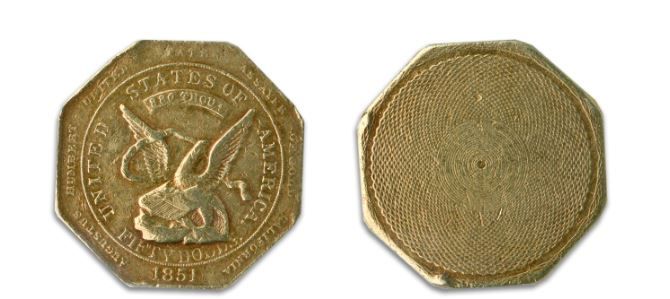A Fascinating Nugget of Gold Rush History
Posted onBoth coinage and paper money in the pre-Civil War United States were a somewhat freewheeling affair. Americans used tens of thousands of types of money. There were federally issued coins, Spanish, French, and Brazilian coins, and paper money issued by state and local banks (anyone could start a bank and start issuing currency). And that doesn’t even take into account the notes issued by semi-legal and illegal banks.

The cornucopia of currencies led economist J.K. Galbraith to comment, “By the time of the Civil War, the American monetary system was, without rival, the most confusing in the long history of commerce and associated cupidity.”
“Territorials” were coins issued by private minters, entrepreneurs, and other enterprising types, filling a gap that the federal government wasn’t. The first territorials appeared in Georgia and North Carolina, the latter being home to the famed Bechtler coins.
After gold was discovered in California, gold dust and nuggets abounded in local communities, but a severe shortage of coinage hampered commerce. It was expensive and dangerous to transport gold back East for coining, and people instead bartered or used the unreliable “pinches” of gold dust to pay for goods and services. The U.S. Constitution prohibited states from issuing money — but not private individuals.
By late 1849, 18 companies in California were issuing territorials. Congress couldn’t agree to authorize a San Francisco mint, due to competing demands for mints in other states, but in 1850, a bill was passed authorizing an Assay Office, which was run by Augustus Humbert. The office had the authority to assay gold and validate its value.
In 1851, Humbert received some private territorials for assaying, and he found that they contained only 97–99% of their stated value. The ensuing negative publicity caused a rush of people attempting to sell of their territorials, which dealers and bankers would only accept for, at most, 80 cents on the dollar. The purchasers then resold the coins to Humbert, who melted them down and produced his own coins.
Interestingly, Humbert’s Assay Office didn’t produce denominations smaller than $10 and $20, because Congress deemed that doing so would make the Assay Office too Mint-like in its powers. In 1853, the Assay Office was closed, and the San Francisco Mint opened a year later.
Humbert’s $50 slugs are octagonal, and the obverse features the words “Augustus Humbert United States Assayer of Gold California 1851” on the edges. Inside a circle, an eagle is surrounded by the words “United States of America.” The reverse side of the slugs show an engraved pattern known as “engine turning,” a technique that was difficult to imitate at the time. The coins are quite heavy, and have a pleasant weight in the hand.
The Humbert $50 coin is unusual in nearly every possible way: it was issued by the U.S. government, but not by a mint. It has eight sides. Its obverse is a pattern rather than an image. The eagle is a notably different design from the eagles on future U.S. coins.
For the investor looking for an unusual addition to a collection, or simply a fascinating slice of Gold Rush history, the Humbert $50 is an unbeatable choice.







